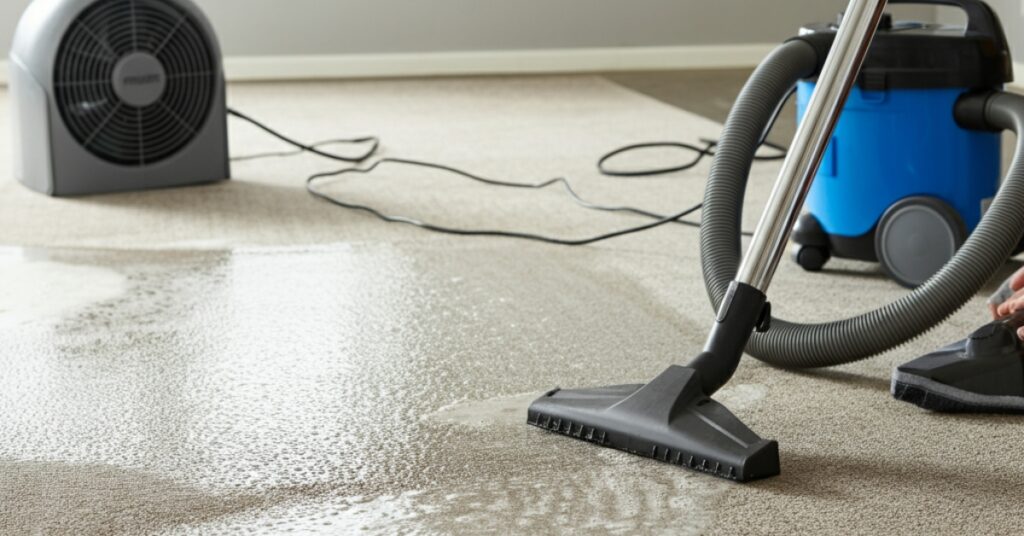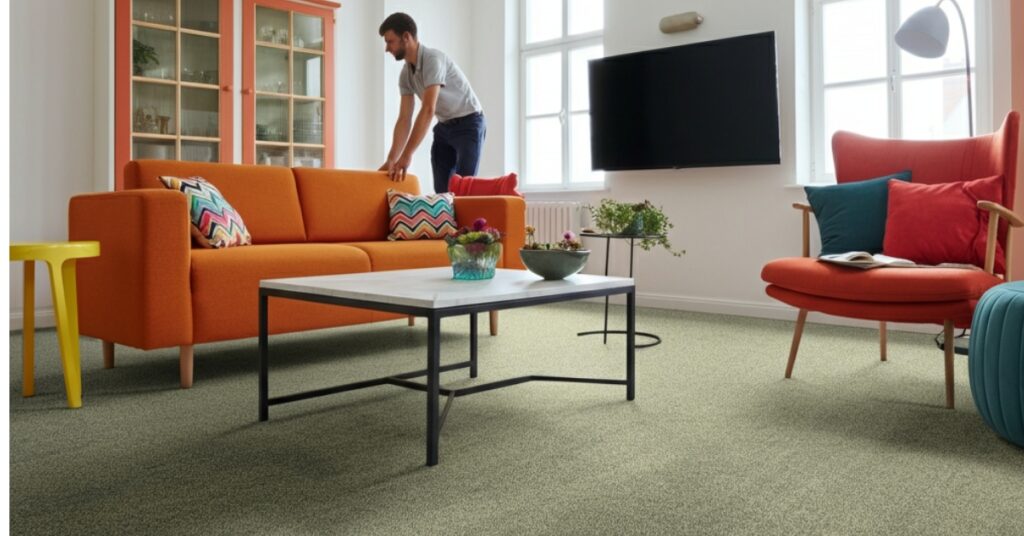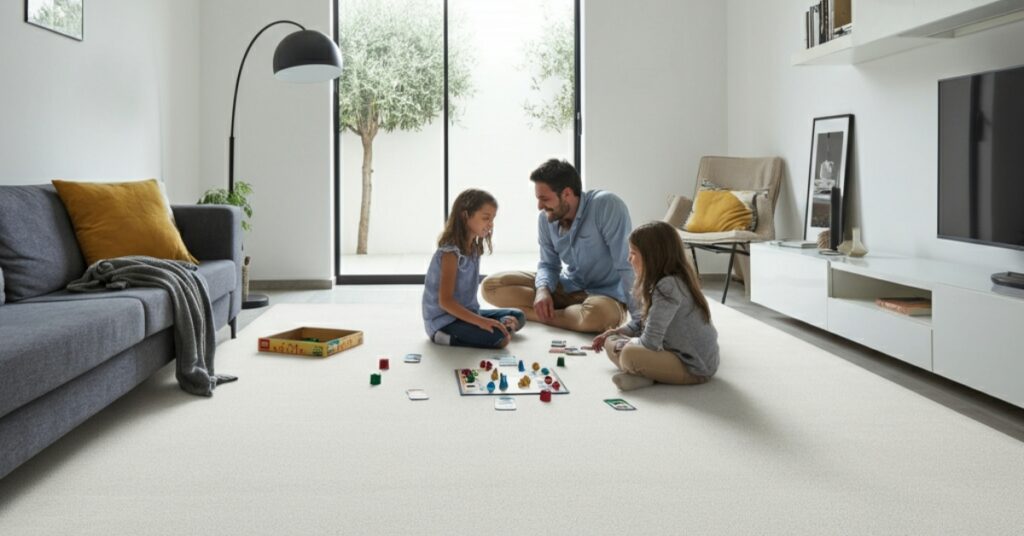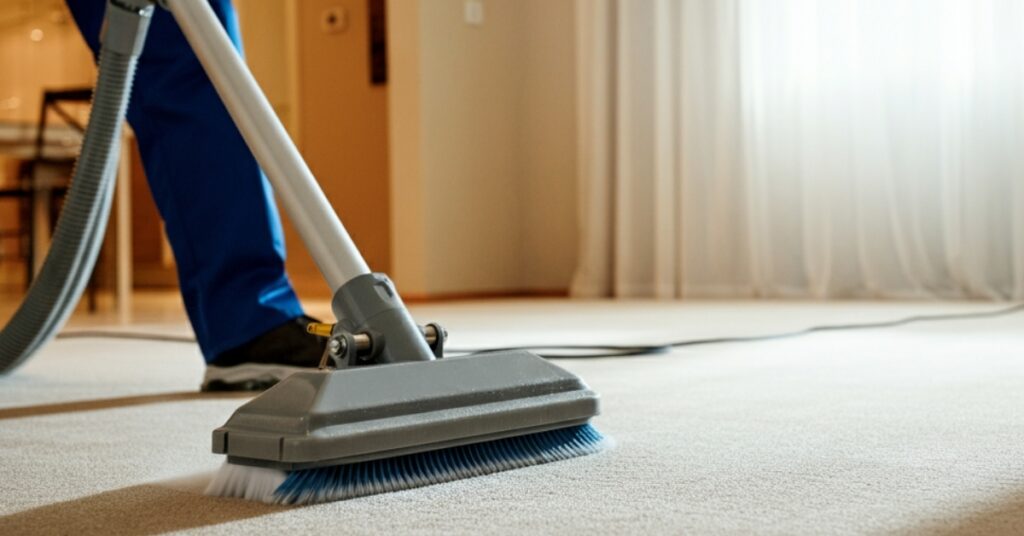As an Amazon Associate, I earn from qualifying purchases.
When flood water soaks your carpets, every minute counts. Carpet flood water removal and drying must begin immediately to prevent permanent damage and dangerous mold growth. Whether caused by burst pipes, heavy rainfall, or appliance leaks, water-damaged carpets pose serious risks to your home’s structure and your family’s health.
Acting quickly can mean the difference between saving your flooring and facing costly replacements. Furthermore, prompt action prevents mold and mildew from taking hold, which can create long-term health hazards and structural problems throughout your home.
This comprehensive guide walks you through the essential steps for effective carpet flood water removal and drying. You’ll learn proven techniques for extracting water, proper drying methods, and when to call professionals. Additionally, we’ll cover the tools you need, how different carpet types require specific approaches, and warning signs that indicate replacement rather than restoration.
Why Immediate Carpet Water Removal Is Crucial
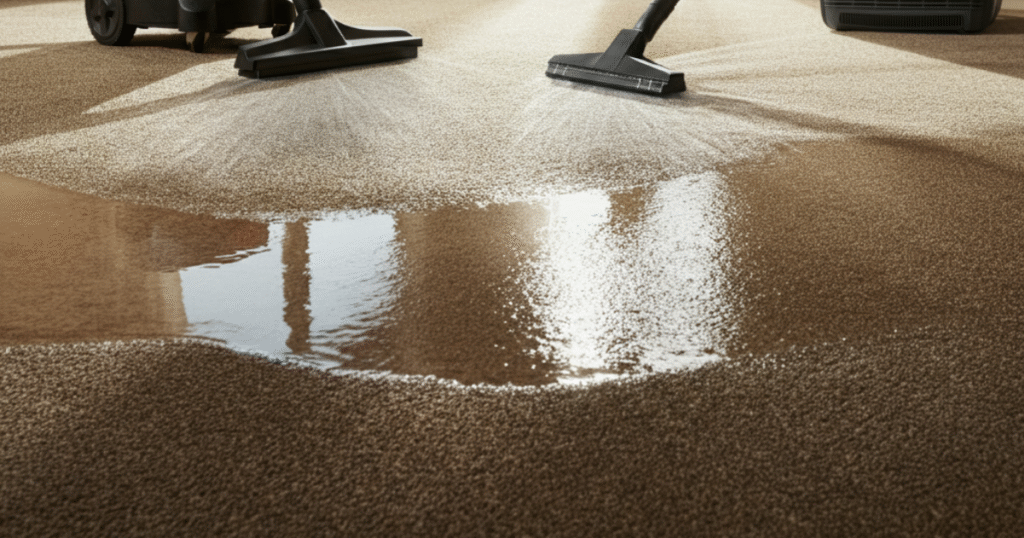
Speed becomes your most valuable asset when dealing with flooded carpets. Consequently, understanding the risks helps motivate quick action and proper response techniques.
Mold and Mildew Risks
Mold spores begin growing within 24-48 hours in wet conditions. Once established, mold spreads rapidly through carpet fibers, padding, and into the subfloor. Moreover, mold releases toxins that cause respiratory problems, allergic reactions, and other health issues. Black mold, in particular, creates severe health risks that require professional remediation.
Structural Damage to Flooring
Water penetrates beyond carpet surfaces into padding and subflooring materials. Wooden subfloors warp, rot, and weaken when exposed to prolonged moisture. Similarly, concrete floors develop cracks and structural issues from water damage. Therefore, quick carpet flood water removal and drying protects your home’s foundation.
Health Hazards from Contaminated Water
Flood water often contains bacteria, sewage, chemicals, and other contaminants. These harmful substances penetrate deep into carpet fibers and padding materials. Without proper sanitization, contaminated carpets become breeding grounds for dangerous pathogens that threaten your family’s health.
Cost Implications of Delayed Action
Immediate response typically costs hundreds of dollars for professional water removal services. However, delayed action leads to thousands in structural repairs, mold remediation, and complete flooring replacement. Insurance companies also scrutinize claims where homeowners failed to act promptly, potentially denying coverage for preventable damage.
Carpet Flood Water Removal & Drying (Step-by-Step Guide)
Follow this systematic approach for effective water removal and carpet restoration. Each step builds upon the previous one, so maintain proper sequence throughout the process.
Step 1: Stop the Water Source
First, locate and shut off the water source causing the flooding. Turn off main water valves for burst pipes, or address roof leaks and drainage issues. Additionally, turn off electricity to affected areas to prevent electrocution hazards. Document the damage with photos for insurance purposes before beginning cleanup.
Step 2: Remove Excess Water
Start carpet flood water removal using a wet/dry vacuum to extract standing water. Work systematically across the entire affected area, overlapping passes to ensure thorough extraction. Press down firmly on the vacuum head to pull water from deep within carpet fibers. For large areas, rent commercial-grade extraction equipment from hardware stores.
Use clean towels and mops to absorb remaining surface water. Replace saturated towels frequently to maintain absorption effectiveness. Work from the outside edges toward the center to prevent spreading contaminated water to clean areas.
Step 3: Lift and Separate Carpet from Padding
Carefully pull carpet away from tack strips along room edges. Lift carpet sections to allow air circulation between carpet and padding layers. If possible, remove carpet entirely and hang outside for faster drying. Similarly, remove damaged padding, as it rarely salvages successfully and often harbors bacteria and mold.
Check the subfloor condition during this process. Look for warping, discoloration, or soft spots that indicate deeper structural damage requiring professional attention.
Step 4: Use Fans and Dehumidifiers
Position multiple fans throughout the room to create cross-ventilation and air movement. Place fans at different heights and angles to maximize airflow across all surfaces. Industrial-grade fans work more effectively than household units for serious water damage situations.
Run dehumidifiers continuously to remove moisture from the air. Empty water collection tanks regularly to maintain optimal performance. Monitor humidity levels with a hygrometer, aiming for below 50% relative humidity to prevent mold growth.
Step 5: Sanitize and Treat for Mold
Apply antimicrobial solutions to cleaned carpet surfaces to eliminate bacteria and prevent mold development. Use EPA-approved disinfectants specifically designed for water damage restoration. Follow manufacturer instructions for proper dilution ratios and contact times.
Steam clean carpets with hot water extraction methods once initial drying is complete. Add antimicrobial agents to cleaning solutions for additional protection against future contamination.
Step 6: Inspect and Decide on Restoration vs. Replacement
Evaluate carpet condition after thorough drying and cleaning. Look for persistent odors, visible staining, or texture changes that indicate permanent damage. Test carpet stability by checking for loose fibers, backing separation, or padding adhesion problems.
Consider replacement for carpets exposed to sewage, chemicals, or contaminated flood water. These situations create health risks that cleaning cannot eliminate completely.
Best Tools & Equipment for Drying Flooded Carpets
Professional-quality equipment significantly improves carpet flood water removal and drying results. Invest in or rent the following essential tools for effective restoration.
Wet/Dry Vacuum
Commercial wet vacuums with powerful suction capabilities remove water more effectively than standard household units. Look for models with large tank capacity to minimize emptying frequency. Additionally, choose units with carpet-specific attachments designed for deep water extraction.
Industrial Fans
High-velocity fans move large volumes of air to accelerate drying times. Axial fans work well for general air circulation, while centrifugal fans provide focused airflow for targeted drying. Position multiple fans strategically to create proper ventilation patterns throughout affected areas.
Dehumidifiers
Refrigerant dehumidifiers work efficiently in warm conditions, while desiccant models perform better in cooler temperatures. Calculate room size and moisture load to select appropriate capacity units. Commercial units process moisture faster than residential models for serious flooding situations.
Moisture Meters
Pin-type moisture meters accurately measure water content in carpet, padding, and subflooring materials. Monitor moisture levels throughout the drying process to ensure complete water removal. Target moisture content below 12% in wood materials and 4% in carpets before considering restoration complete.
Carpet Shampooers with Disinfectant
Hot water extraction machines deep clean and sanitize water-damaged carpets simultaneously. Use antimicrobial cleaning solutions to eliminate bacteria and prevent future contamination. Multiple cleaning passes may be necessary for heavily soiled or contaminated carpets.
How to Handle Different Carpet Types & Padding
Different carpet materials and construction methods require specific approaches during carpet flood water removal and drying processes.
Wool vs. Synthetic Carpets
Wool carpets absorb more water and dry slower than synthetic materials. Therefore, wool requires gentler extraction methods to prevent fiber damage and shrinkage. Use lower heat settings during cleaning and drying to preserve natural fibers.
Synthetic carpets like nylon and polyester resist water absorption and dry faster. These materials tolerate aggressive extraction methods and higher temperatures during restoration processes.
Foam vs. Rubber Padding
Foam padding disintegrates when saturated with water and requires immediate replacement. Attempting to dry foam padding often results in crumbling and permanent damage. Remove and dispose of water-damaged foam padding promptly.
Rubber padding may survive minor water exposure if dried quickly and thoroughly. However, prolonged saturation causes deterioration and odor problems. Inspect rubber padding carefully for signs of breakdown or contamination before attempting restoration.
Tips for Glued-Down vs. Tacked Carpets
Tacked carpets lift easily for thorough drying and padding inspection. Remove tacks carefully to avoid damage, and reinstall using the same holes when possible. Clean and dry tack strips before carpet reinstallation.
Glued-down carpets present greater challenges during water damage restoration. Adhesive weakens when wet, causing carpet sections to lift unevenly. Professional removal may be necessary to prevent permanent damage during restoration attempts.
When to Salvage and When to Replace
Replace carpets exposed to sewage, chemicals, or flood water from contaminated sources. These situations create health hazards that cleaning cannot eliminate safely. Additionally, replace carpets showing signs of delamination, severe staining, or persistent odors after proper cleaning.
Salvage carpets from clean water sources when prompt action prevents mold growth and structural damage. Success depends on quick response, thorough drying, and proper sanitization procedures.
Taking Action to Protect Your Home

Swift response to carpet flooding protects both your property and your family’s health. Remember that carpet flood water removal and drying must begin immediately to prevent permanent damage and dangerous mold growth. The techniques outlined in this guide provide a solid foundation for effective restoration efforts.
However, extensive damage or contaminated water situations require professional intervention. Water damage restoration specialists possess advanced equipment and expertise to handle complex situations safely. Don’t hesitate to contact professionals when damage exceeds your capabilities or involves health risks.
Prevention remains your best defense against future flooding incidents. Install water detection systems, maintain plumbing regularly, and address drainage problems promptly. These proactive measures help avoid the stress and expense of emergency carpet water removal situations. For the next step, check out our guide on how to dry carpet after cleaning.
Frequently Asked Questions
Can I dry a flooded carpet myself or should I call a professional?
Yes, you can handle minor flooding from clean water sources using proper techniques and equipment. However, call professionals for contaminated water, extensive damage, or when mold growth is suspected.
How long does it take to fully dry a carpet after flooding?
Typically 24-72 hours with proper equipment and ventilation. Thick carpets, high humidity, and poor airflow extend drying times significantly.
Will my carpet smell after flood water exposure?
Yes, persistent odors often develop without proper cleaning and sanitization. Antimicrobial treatments and thorough drying prevent most odor problems.
Can I reuse the carpet padding after a flood?
No, padding rarely salvages successfully after water damage. Foam padding disintegrates, while rubber padding harbors bacteria and develops odors.
What are signs that mold is growing under the carpet?
Yes, look for musty odors, visible dark spots, increased allergic reactions, or persistent dampness after drying attempts. These indicate potential mold growth requiring professional inspection.
As an Amazon Associate, I earn from qualifying purchases.

